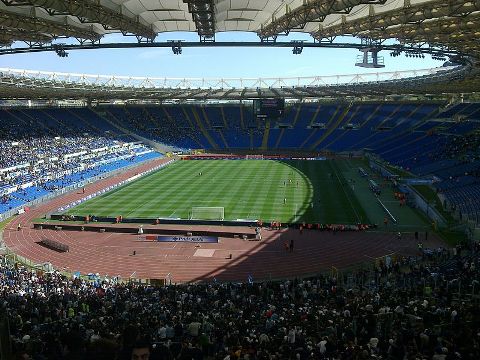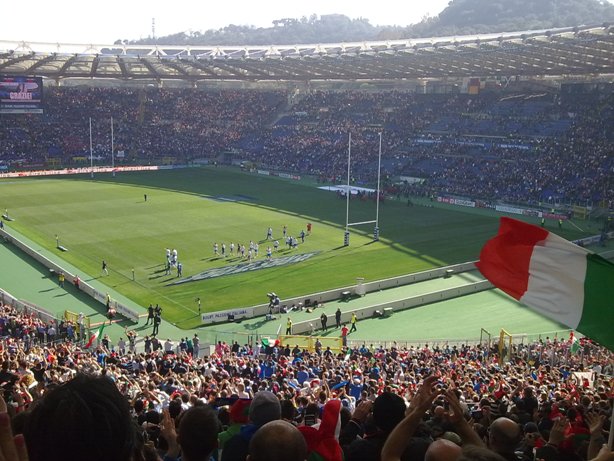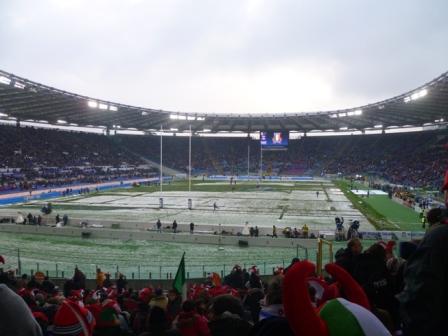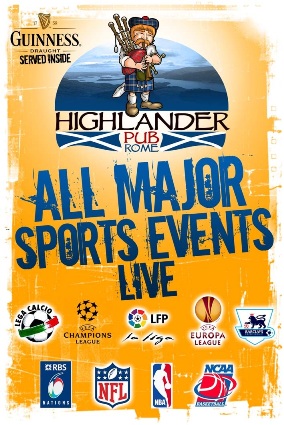Italy - Stadio Olimpico

Rugby
has been played in Italy for over 100 years, and the Federazione
Italiana Rugby (FIR) was formed in 1928. Although football, basketball
and cycling make most of the headlines in the country, rugby union has
a strong following, particularly in the North where the majority of
clubs are based, including Treviso and Zebre who compete in the
RaboDirect Pro12.
The Azzurri have improved both on and off the pitch since joining the
Six Nations, defeating several of the more established sides. Their
pride in the shirt and determination to succeed has however earned the
affection of the locals, who have been been attending in ever
increasing numbers, leading to the side switching from their original
home at the Stadio Flaminio to the larger Stadio Olimpico in 2012.
Whilst the Stadio Olimpico hosts all Six Nations games, in an effort to
spread the rugby gospel the federation do like to host other
internationals around the country.
Italy have competed at all six Rugby World Cups, without ever making it
past the group stage. The FIR have ambitions to host the tournament
though, having made unsuccessful bids for the 2015 (England) and 2019
(Japan) tournaments. If they do get the chance to host a World Cup, it
will be a great opportunity to further the growth of the sport
throughout the nation, with much of the infrastructure already in place.
Ground Information Back to Top ^
Opened in 1928, the Stadio Olimpico has a capacity of just over 70,000. The stadium has undergone many redevelopments over the years (most recently in 2007) and today boasts smart modern facilities. It is located around 4km North of the City within the Foro Italico sports complex.
The stadium's stands along the touchlines are the Monte Mario
and Tribuna Tevere, and as expected are where the more expensive
tickets are located due to their proximity to the pitch. Behind the
posts are the Curva Nord and Curva Sud, where the bends of the running
track mean that supporters are far from the pitch, although tickets are
priced to reflect this. The Curva Sud is is the larger of the two,
whilst three corners of the ground are known as the Distinti.

As it also acts as an athletics stadium, there is unfortunately a large running track around the pitch that separates supporters from the action a little. Despite the distance from the pitch for some supporters, the atmosphere in the stadium can be fantastic - particularly if the home side are performing well.
View from the Curva before a
snowy Six Nations match
Getting There Back to Top ^
The majority of inter-city trains arrive at Termini station to the East of the City Centre. The station is a main hub of the Italian rail network, with services operating to Florence, Naples and Pisa amongst others. International rail services also operate to destinations including Paris, Munich, Geneva and Vienna. Both of the city's metro lines stop at Termini also.
RailEurope offers tickets and timetable information.
By Train (to the Ground)
The stadium is served by Rome's Tramline 2, with the Mancini stop located nearby. Connections to the tramline can be made from metro stop Flaminio Piazza Popolo. You can purchase single (Biglietto) or unlimited day tickets (Biglietto Giornaliero) from Tabacchi shops or metro stations. Make sure to validate your ticket in the yellow machines before boarding.
By Bus
The #32 bus from metro stop Ottaviano will take you to Stadio Tennis, a short walk from the stadium.
By AirRome Fiumicino
Fiumicino is the
principal airport serving the city, and the largest airport in Italy.
Many of the world's flag carriers (including Aer Lingus, British
Airways, Air France and Alitalia) have a presence at the airport, as do
budget carriers Easyjet, Jet2.com and Valencia. Scheduled services
operate to Birmingham, Bordeaux, Bristol, Dublin, Leeds/Bradford,
London (Gatwick, Heathrow and Luton), Lyon, Manchester, Paris (CDG and
Orly) and Toulouse amongst others.
Fiumicino is around 30km from the city, and getting into town is easy -
regular express trains (known as the Leonardo Express) take 35 minutes
to Termini station, where the metro can take you on to your final
destination. As it's primarily a tourist train, the tickets are quite
expensive so if you want to save your pennies consider taking the
Metropolitan train to Tiburtina or Ostiense station where you can
connect to Metro Line B. Note that for both services you need to get
your ticket validated in the yellow machines prior to boarding.
Alternatively, Terravision and Sitbus
buses take a little longer (around an hour to Termini station) but are
the cheapest way to travel between the airport and City.
Ciampino Airport
Ciampino is the Roman base for budget airlines Ryanair and Wizzair.
Scheduled flights operate to Dublin, East Midlands, Edinburgh, Glasgow
(Prestwick), London (Stansted), Manchester and Paris (Beauvais).
Unlike the majority of airports of this kind, Ciampino is actually
within easy reach of the city centre. Either take a direct bus to
Termini station (Terravision or Sitbus)
or take a local bus to Anagina station to connect to Metro Line
A.
Drinking Back to Top ^
Alcohol is widely available both inside and outside of the stadium, with beer tents set up and plenty of bars within the ground itself.
Before/After the Game
As rugby is not the sport of the masses in Italy (and especially not in Rome), you probably need to plan ahead to find somewhere showing televised rugby.
- Scottish pub The Highlander on Vicolo di San Biagio (close to Piazza del Popolo) is a safe bet, offering a guarantee to show all 6 Nations matches.
- As ever the safe bet for watching rugby when abroad, Irish pub The Abbey Theatre on Via del Governo Vecchio (just off Piazza Navona) will also show all 6 Nations matches and also offers free return travel to the stadium on certain matchdays - check their website in advance for details.

Eating Back to Top ^
Sleeping Back to Top ^
There are a wide range of accommodation options in Rome befitting one of the world's most popular tourist destinations. There are a few options in the area around the stadium, including the Hotel Villa Glori and Villa Riccio. The majority of fans will however opt to stay closer to the city centre and travel out to the stadium.Make a Trip of It Back to Top ^
Rome is known as the Eternal City, and is the home of Roman Empire, the Vatican City and a UNESCO World Heritage Site to boot. Combine the sights and attractions with great food and culture, and you could easily spend a week exploring and enjoying the city, if your budget can stretch!Key Information
- Capacity
70,634 - Address
Via Foro Italico
00194
Rome - Website
www.federugby.it
Disabled Supporters
- Can you add information to this section? Let us know here!
Ground Facts
- Italy moved their national rugby fixtures to the Stadio
Olimpico in 2012, when they had outgrown their previous home nearby at
the Stadio Flaminio.
- The Olimpico is primarily a soccer stadium, home to Serie A
sides Lazio and Roma.
- It has hosted several major events, including the 1960 Olympics, 1990 World Cup and several European soccer cup finals.
Early Starters
- Although relatively new on the world rugby scene, Italy
have been competing in international fixtures since 1929, when they
lost 9-0 to Spain in Barcelona.
Six Nations Inclusion
- Italy joined England, Wales, Ireland, Scotland and France
to form the Six Nations Championship in 2000.
- They started in some style, defeating Scotland 34-20 in their first fixture in Rome.
Add Your Information
- Got something to add? Spotted a mistake? The Rugby Ground
Guide is dependent on your input to make it work
- You can submit information or images here.


